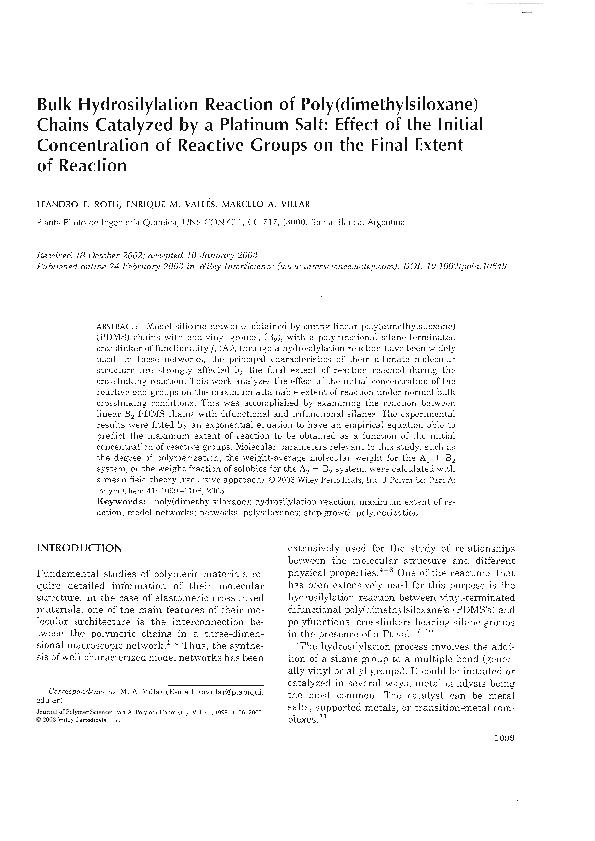Mostrar el registro sencillo del ítem
dc.contributor.author
Roth, Leandro E.
dc.contributor.author
Vallés, Enrique M.
dc.contributor.author
Villar, Marcelo Armando

dc.date.available
2020-03-30T21:35:12Z
dc.date.issued
2003-02-24
dc.identifier.citation
Roth, Leandro E.; Vallés, Enrique M.; Villar, Marcelo Armando; Bulk hydrosilylation reaction of poly(dimethylsiloxane) chains catalyzed by a platinum salt: Effect of the initial concentration of reactive groups on the final extent of reaction; John Wiley & Sons Inc; Journal of Polymer Science Part A: Polymer Chemistry; 41; 8; 24-2-2003; 1099-1106
dc.identifier.issn
0887-624X
dc.identifier.uri
http://hdl.handle.net/11336/101431
dc.description.abstract
Model silicone networks obtained by curing linear poly(dimethylsiloxane) (PDMS) chains with end-vinyl groups, (B2), with a polyfunctional silane-terminated crosslinker of functionality f, (Af), through a hydrosilylation reaction have been widely used. In these networks, the principal characteristics of their ultimate molecular structure are strongly affected by the final extent of reaction reached during the crosslinking reaction. This work analyzes the effect of the initial concentration of the reactive end groups on the maximum attainable extent of reaction under normal bulk crosslinking conditions. This was accomplished by examining the reaction between linear B2 PDMS chains with difunctional and trifunctional silanes. The experimental results were fitted by an exponential equation to have an empirical equation able to predict the maximum extent of reaction to be obtained as a function of the initial concentration of reactive groups. Molecular parameters relevant to this study, such as the degree of polymerization, the weight-average molecular weight for the A2 + B2 system, or the weight fraction of solubles for the A3 + B2 system, were calculated with a mean field theory (recursive approach).
dc.format
application/pdf
dc.language.iso
eng
dc.publisher
John Wiley & Sons Inc

dc.rights
info:eu-repo/semantics/openAccess
dc.rights.uri
https://creativecommons.org/licenses/by-nc-sa/2.5/ar/
dc.subject
Model silicone networks
dc.subject
Hydrosilylation reaction
dc.subject
Maximum extent of reaction
dc.subject
Initial concentration of reactive groups
dc.subject.classification
Ingeniería Química

dc.subject.classification
Ingeniería Química

dc.subject.classification
INGENIERÍAS Y TECNOLOGÍAS

dc.title
Bulk hydrosilylation reaction of poly(dimethylsiloxane) chains catalyzed by a platinum salt: Effect of the initial concentration of reactive groups on the final extent of reaction
dc.type
info:eu-repo/semantics/article
dc.type
info:ar-repo/semantics/artículo
dc.type
info:eu-repo/semantics/publishedVersion
dc.date.updated
2020-03-25T14:39:19Z
dc.journal.volume
41
dc.journal.number
8
dc.journal.pagination
1099-1106
dc.journal.pais
Estados Unidos

dc.journal.ciudad
Hoboken
dc.description.fil
Fil: Roth, Leandro E.. Consejo Nacional de Investigaciones Científicas y Técnicas. Centro Científico Tecnológico Conicet - Bahía Blanca. Planta Piloto de Ingeniería Química. Universidad Nacional del Sur. Planta Piloto de Ingeniería Química; Argentina
dc.description.fil
Fil: Vallés, Enrique M.. Consejo Nacional de Investigaciones Científicas y Técnicas. Centro Científico Tecnológico Conicet - Bahía Blanca. Planta Piloto de Ingeniería Química. Universidad Nacional del Sur. Planta Piloto de Ingeniería Química; Argentina
dc.description.fil
Fil: Villar, Marcelo Armando. Consejo Nacional de Investigaciones Científicas y Técnicas. Centro Científico Tecnológico Conicet - Bahía Blanca. Planta Piloto de Ingeniería Química. Universidad Nacional del Sur. Planta Piloto de Ingeniería Química; Argentina
dc.journal.title
Journal of Polymer Science Part A: Polymer Chemistry

dc.relation.alternativeid
info:eu-repo/semantics/altIdentifier/doi/http://dx.doi.org/10.1002/pola.10649
dc.relation.alternativeid
info:eu-repo/semantics/altIdentifier/url/https://onlinelibrary.wiley.com/doi/abs/10.1002/pola.10649
Archivos asociados
